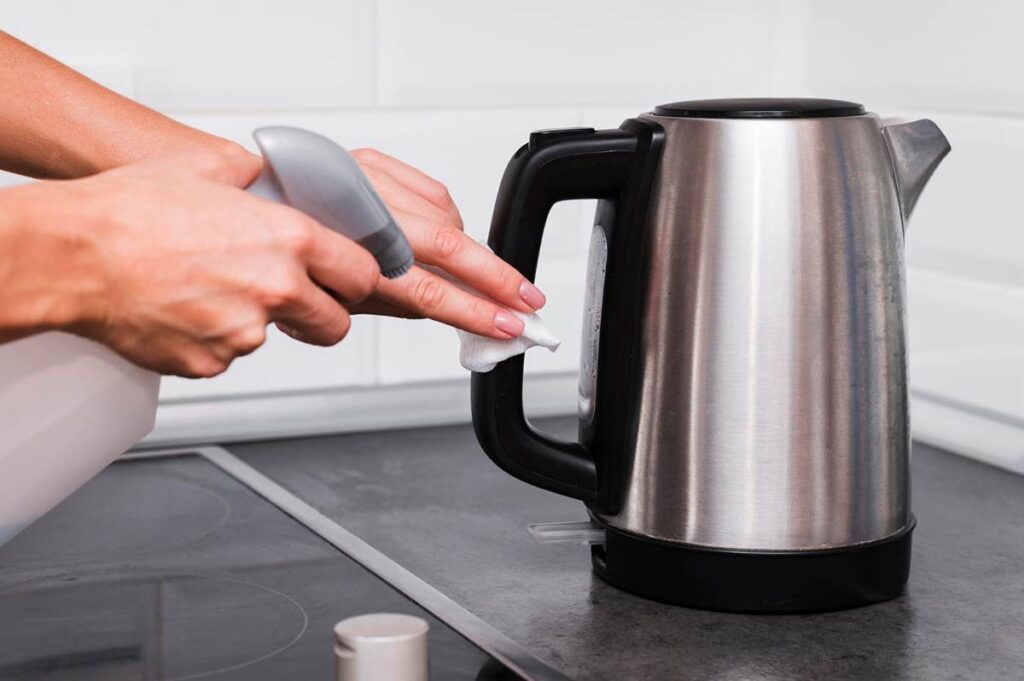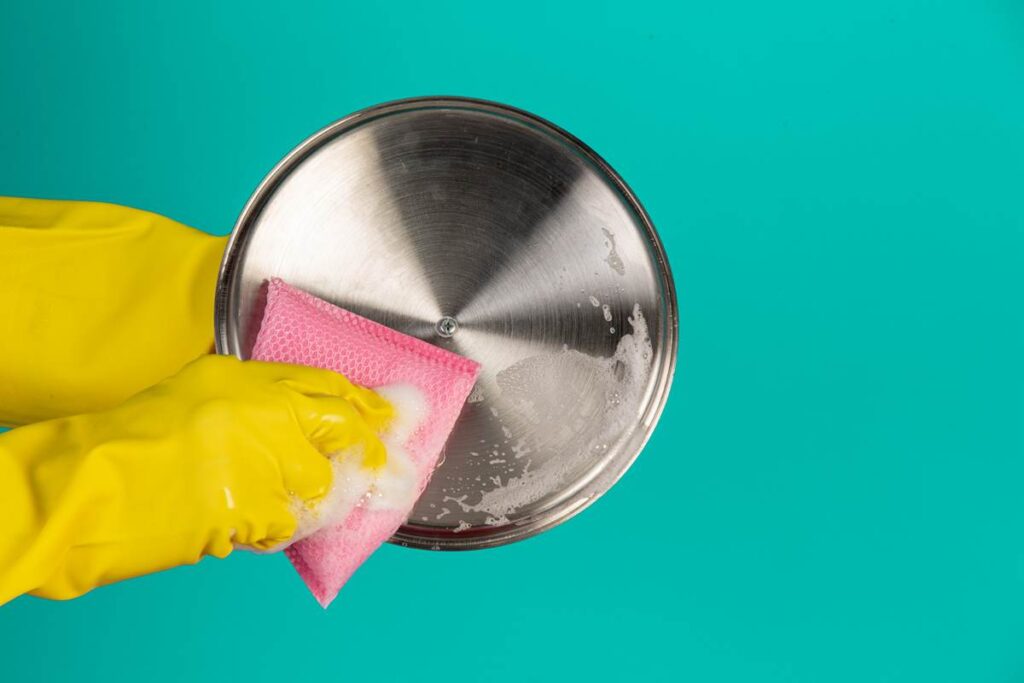Rust on stainless steel can be annoying, especially when you see it on your kitchen sink, knives, or favorite tools. Even though it’s called “stainless,” this type of steel can still get rusty if it’s not cared for properly. But don’t worry — we’re here to help! In this guide, you’ll learn how to remove rust from stainless steel using safe and easy home methods. No strong chemicals needed! From vinegar tricks to baking soda hacks, we’ll show you simple ways to clean the rust and make your stainless steel items look shiny and new again.
What Causes Rust on Stainless Steel?
You might think stainless steel can’t rust — but it actually can. Even though it’s made to fight rust, stainless steel isn’t 100% safe from it.
So, why does stainless steel rust? Here are the main reasons:
Common Causes of Rust:
- Moisture – Water left on the surface can slowly lead to rust.
- Salt – Salt from food or the air (especially near the sea) can damage the steel coating.
- Poor Cleaning – If you don’t clean it often, dirt and grime can trap moisture, leading to rust.
- Scratches – Scratches remove the protective layer, making it easier for rust to form.
Basic Tools and Items You’ll Need
Before we show you how to remove rust from stainless steel, let’s gather the simple tools and ingredients. The best part? Most of these are already in your kitchen!
You’ll Need:
- Soft cloth or sponge – for gentle cleaning without scratches
- Baking soda – a mild cleaner that helps scrub off rust
- White vinegar – helps break down rust naturally
- Lemon juice – works great on small rusty spots
- Cream of tartar – combines well with lemon for a strong mix
- Dish soap – removes grease and dirt
- Non-abrasive scrub pad – safe for stainless steel surfaces
- Rubber gloves – protect your hands while cleaning
How to Remove Rust from Stainless Steel at Home
Now that you have your tools ready, let’s go step by step. These home methods are safe, cheap, and really work. Whether it’s a sink, knife, or screw — here’s how to remove rust from stainless steel using everyday items.
Use Baking Soda Paste
Baking soda is gentle but powerful when it comes to removing rust.
Steps:
- Mix 1 tablespoon of baking soda with water to make a thick paste
- Apply the paste directly to the rust spot
- Let it sit for 15–20 minutes
- Gently scrub with a soft sponge or cloth
- Rinse with clean water and dry with a towel
Remove Rust with White Vinegar
White vinegar is a natural rust cleaner for stainless steel, and it’s perfect for deep cleaning.
For small items (like screws or blades):
- Soak the item in white vinegar for 1–2 hours
- Take it out and scrub with a sponge or toothbrush
- Rinse and dry completely
For larger surfaces (like sinks):
- Pour or spray vinegar on the rusty area
- Let it sit for 10–15 minutes
- Scrub gently with a non-abrasive pad
- Rinse thoroughly and dry
Try Lemon Juice and Salt
Lemon is acidic and salt is rough, so together they make a strong cleaning team!
Steps:
- Sprinkle salt over the rust spot
- Squeeze lemon juice on top and let it soak for 1–2 hours
- Gently scrub with a soft sponge
- Wipe clean with a cloth and rinse with water
How to Remove Rust from Stainless Steel Sink

Rust on your stainless steel sink is a common problem, but it’s easy to fix with the right methods. Here’s how to get your sink shiny and rust-free using safe, everyday items.
Use Vinegar Spray + Baking Soda Paste
This combination works wonders to remove rust from stainless steel sink without harming the surface.
Steps:
- Spray white vinegar generously onto the rust spots
- Let it sit for about 10 minutes to break down the rust
- Apply a baking soda paste (mix 1 tbsp baking soda with a little water) to the rusty area
- Gently scrub with a soft cloth or sponge
- Rinse with warm water and wipe dry
Avoid Steel Wool or Hard Scrubbing Pads
Steel wool and abrasive pads may seem like a quick solution, but they can scratch and damage the finish of your sink. Stick to soft sponges or non-abrasive scrub pads for a safer, long-lasting clean.
Wipe Dry After Cleaning to Prevent New Rust
After cleaning, always wipe your sink dry with a clean cloth. This step helps prevent new rust spots by removing excess moisture.
Pro Tip: Dry your sink daily after use to avoid water spots and new rust. Regular drying keeps your stainless steel sink looking fresh and shiny.
How to Remove Rust from Stainless Steel Knives
Rust spots on your stainless steel knives are not only unsightly, but they can also affect their performance. Luckily, you can clean them safely with simple household items.
Use Lemon + Baking Soda for Small Spots
For small rust spots on your knife blade, a lemon and baking soda paste is a great solution.
Steps:
- Sprinkle baking soda over the rust spot
- Squeeze fresh lemon juice on top to form a paste
- Let it sit for 10-15 minutes to break down the rust
- Gently scrub the rusted area with a soft sponge or cloth
- Rinse with warm water and dry thoroughly
Soak Blade in Vinegar (But Not the Handle)
For rust that’s harder to remove, soaking your knife blade in white vinegar is an effective solution. Just make sure not to soak the handle, especially if it’s made of wood or other sensitive materials.
Steps:
- Submerge the blade only into white vinegar for about 30 minutes
- After soaking, scrub gently with a soft sponge or toothbrush
- Rinse the knife thoroughly and dry it well
Always Dry Knives After Washing to Avoid Future Rust
To prevent future rust from forming, it’s essential to dry your knives immediately after washing them. Leaving knives wet or damp allows moisture to cause rust spots over time.
Other Home Remedies for Rust Removal
If you’re looking for more home remedies for rust removal, there are several easy and gentle options that are safe for your kitchen tools and other stainless steel items.
Cream of Tartar + Hydrogen Peroxide Paste
This natural rust remover is a simple and effective solution, especially for small rust spots.
Steps:
- Mix cream of tartar with hydrogen peroxide to form a thick paste
- Apply the paste directly to the rusted area
- Let it sit for 10–15 minutes
- Gently scrub with a soft sponge or cloth
- Rinse with water and dry thoroughly
Potato + Dish Soap Method (Potato Contains Oxalic Acid)
Potato is surprisingly effective at removing rust due to its oxalic acid content, which breaks down the rust.
Steps:
- Cut a potato in half and apply a small amount of dish soap on the cut surface
- Rub the potato directly onto the rust spots
- Let it sit for about 15 minutes
- Scrub gently with a non-abrasive sponge
- Rinse and dry well
Use Toothpaste (Non-Gel) for Light Rust
Toothpaste, especially the non-gel type, can act as a mild abrasive to remove light rust spots.
Steps:
- Apply a small amount of non-gel toothpaste to the rusted area
- Scrub gently with a soft sponge or toothbrush
- Rinse with water and dry with a cloth
Other Home Remedies for Rust Removal

If you prefer using natural home remedies for rust removal, there are several effective options that won’t damage your stainless steel items.
Cream of Tartar + Hydrogen Peroxide Paste
This easy-to-make paste is excellent for removing rust from small spots on your stainless steel items.
Steps:
- Combine cream of tartar and hydrogen peroxide to form a thick paste
- Apply the paste to the rusted areas and let it sit for 10-15 minutes
- Gently scrub with a soft cloth or sponge
- Rinse with water and dry thoroughly
Potato + Dish Soap Method (Potato Contains Oxalic Acid)
Potatoes contain oxalic acid, which works as a natural rust remover. Paired with dish soap, it’s a safe option for everyday kitchen tools.
Steps:
- Cut a potato in half and apply a bit of dish soap on the cut surface
- Rub the potato directly on the rusted spots
- Allow it to sit for about 15 minutes
- Gently scrub with a non-abrasive sponge
- Rinse and dry well
Use Toothpaste (Non-Gel) for Light Rust
Non-gel toothpaste can be a surprising rust remover. It’s a mild abrasive that works well for light rust.
Steps:
- Apply a small amount of non-gel toothpaste to the rusted area
- Scrub gently with a soft sponge or toothbrush
- Rinse with water and dry thoroughly
Our Bonus Expert Tips
In this guide apart and ensures the advice is more reliable, informative, and actionable compared to what you might find with other sources.
Real-Life Kitchen Cleaning & DIY Use
We base our advice on real-life experiences. Our tips come from years of cleaning rust from stainless steel in kitchens and homes, so you can trust the methods to work in your own space. These aren’t just theoretical ideas—they’re practical solutions that people use every day.
When to Use Which Method for Which Item
Not all rust removal methods are suitable for every type of stainless steel item. Knowing when and how to use a particular method can make all the difference. For instance, baking soda paste might work great for knives but could be too abrasive for a delicate sink. We’ll guide you on which method to use based on the item you’re cleaning.
Safe Household Items & Their Chemical Actions
We recommend safe household items like baking soda, vinegar, and lemon juice because of their natural chemical actions. These ingredients work by breaking down rust particles without damaging your items. We’ll also explain the chemical properties behind these natural cleaners, so you understand how they work on a molecular level.
Avoiding Harsh Chemicals & Risky DIY Hacks
While some people might suggest risky DIY methods like toxic chemicals or harsh abrasives, we warn against these. Harsh chemicals can damage your stainless steel and pose a health risk. Instead, we focus on safe, natural methods that protect both your stainless steel items and your health.
Unique Additions:
Here are a couple of things competitors often overlook:
- Potato Method: This simple rust remover is missed by many, even though it works well for light rust spots. Potato + dish soap is an excellent natural solution for rust removal without harming your steel items.
- Table Comparing Natural vs. Store-Bought Cleaners: We’ve added a comparison table below to help you decide whether to use natural remedies or commercial cleaners based on your needs and preferences.
- Safety Checklist Before Cleaning: Before starting any rust removal task, it’s important to make sure you’re following a safe cleaning process to avoid any damage. We provide a checklist of things to do before you start cleaning.
Natural vs. Store-Bought Rust Removers
Here’s a comparison table to help you quickly assess the pros and cons of natural versus store-bought rust removers:
| Method | Cost | Safe for Kitchen? | Easy to Use |
| Baking Soda + Vinegar | Very low | ✅ Yes | ✅ Easy |
| Lemon + Salt | Low | ✅ Yes | ✅ Easy |
| Commercial Rust Spray | Moderate | ⚠ Sometimes | ✅ Fast |
FAQs
Can I use cola to clean rust?
Yes, cola has mild acid that can help — but it’s sticky and not ideal for kitchen tools. Stick to safer, non-abrasive methods.
Will rust come back?
If not dried properly or exposed to salt/water, yes. Always dry your tools immediately after cleaning to prevent rust.
Can I use bleach?
No! Bleach damages stainless steel and makes rust worse. Avoid bleach to protect your items.
What is the fastest way to remove rust from stainless steel?
Using white vinegar or a baking soda paste is fast and effective for removing rust from stainless steel.
Can vinegar remove rust from stainless steel?
Yes, vinegar is an effective rust remover, especially for small items like screws. It helps break down rust without damaging the steel.
Can toothpaste remove rust from stainless steel?
Yes, non-gel toothpaste can work for light rust stains. Its mild abrasives gently scrub off rust without harming the surface.
Is rust on stainless steel permanent?
No, rust is not permanent. With proper cleaning and maintenance, you can easily remove rust and prevent it from coming back.
What is the best homemade rust remover?
A baking soda paste mixed with water or a lemon and salt solution are among the best homemade rust removers for stainless steel.
Conclusion
Removing rust from stainless steel is easy when you use the right method. Whether you’re cleaning a sink, knife, or any steel item, now you know how to remove rust from stainless steel safely at home. Just use natural remedies like vinegar, baking soda, or lemon — and remember to keep everything dry to stop rust from coming back.










